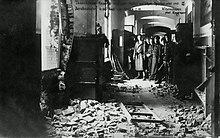Black Hunter Freikorps
The “Black Jäger” Freikorps was an independent paramilitary association set up in Wilhelmshaven in 1919 .
history
Lineup
The Freikorps was set up in January 1919 and was mainly used to “restore public order”. Most of its members came from the Marine Infantry Regiments No. 2 and No. 3, established in 1914, which in turn came from the II. And III. Sea battalion emerged . Further members were brought into the volunteer corps through recruitment. Interested officers, NCOs and men were able to report to the designated advertising points or directly in the office of the former Second Sea Battalion in Wilhelmshaven. The volunteers received a fixed wage and a daily allowance of five marks.
A special distinguishing feature was the marines' dark coat, which is why the French called them "Chausseurs noirs" ("Black Hunters"). This designation was later taken into account when giving the name.
Calls
One of the first missions on the night of January 27-28, 1919 in Wilhelmshaven was remarkable. That night the “Black Jäger” volunteer corps , in cooperation with other volunteer organizations , stormed the headquarters of the “Revolutionary Committee” in the “1000-man barracks” of the marine infantry in Wilhelmshaven. The entrenched revolutionaries were finally forced to surrender by means of artillery bombardment, resulting in deaths and injuries. After this mission, the Freikorps took over the guard and security service in the city of Wilhelmshaven from March to June 1919. The Freikorps was then relocated to the border area of the eastern border of the Reich and used in the border and protection service as part of the Eastern Border Guard .
Whereabouts
After the end of the mission on the eastern border, the Freikorps was merged with the Jäger Battalion "Greater Hamburg". The rifle battalion went later in the first battalion of infantry - regiment 18 of the Provisional Reichswehr on.
Uniform and badge
The uniform corresponded to that of the former imperial marine infantry and the sea battalions. As a special identification, the members of the volunteer corps wore silver deer antlers with a black skull on their left upper arm. The black skull was also worn on the hat.
Structure and staffing
- Free Corps "Black Hunters" ( Major / Lieutenant Colonel Paul Schneider)
literature
- Rainer Wohlfeil, Hans Dollinger: The German Reichswehr. Pictures, documents, texts. On the history of the Hundred Thousand Man Army 1919–1933. Bernard & Graefe, Frankfurt a. M. 1972, ISBN 978-3-7637-5109-9 , p. 31.
- Georg Tessin: German associations and troops: 1918–1939. Biblio Verlag, Osnabrück 1974, ISBN 978-3-7648-1000-9 , p. 71, p. 115, p. 165.
- Rolf Klodt: At sea and on land . Report-Verlag, Bonn 2008, ISBN 978-3-932385-28-5 .
Web links
Individual evidence
- ↑ a b c d e Rolf Klodt: At sea and on land. Report-Verlag, Bonn 2008, p. 70 f.
- ↑ Originated from the "Wachabteilung Bahrenfeld" or the Reichswehr Battalion "Greater Hamburg". see. Military history research institute of the army (ed.): The turmoil in the Reich capital and in northern Germany 1918–1920 (= depictions of the post-war battles of German troops and volunteer corps. Volume 6). ES Mittler & Sohn, Berlin 1940, p. 223.
- ↑ War History Research Institute of the Army (ed.): The chaos in the Reich capital and in northern Germany 1918–1920 (= depictions of the post-war battles of German troops and volunteer corps. Volume 6). ES Mittler & Sohn, Berlin 1940, p. 223.
- ^ Rolf Klodt: At sea and on land . Report-Verlag, Bonn 2008, p. 76.

